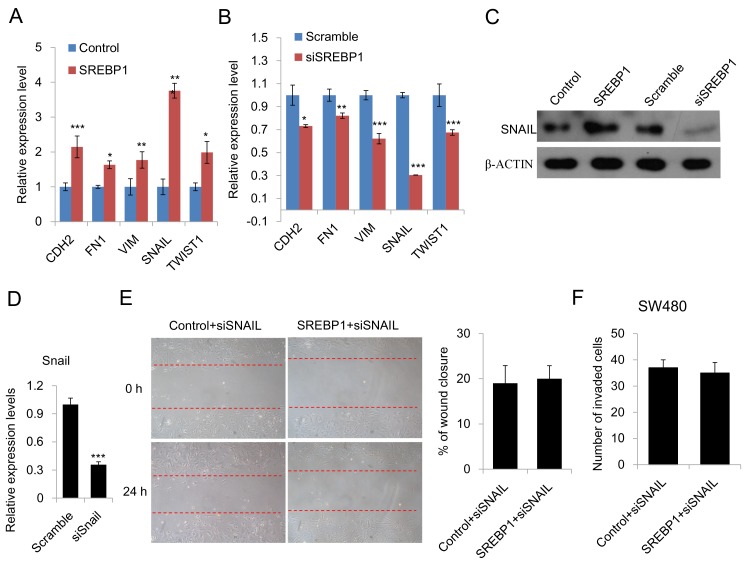Figure 3.
SREBP1 promotes EMT by increasing SNAIL expression. (A) qPCR analysis of the expression of EMT-related genes in CRC cells transfected with SREBP1 or a control vector. Data are presented as the mean ± standard deviation of three independent experiments. *P<0.05, **P<0.01 and ***P<0.001 vs. control. (B) qPCR analysis of the expression of EMT-related genes in CRC cells transfected with SREBP1 siRNA or scramble siRNA. Data are presented as the mean ± standard deviation of three independent experiments. *P<0.05, **P<0.01 and ***P<0.001 vs. scramble. (C) Western blot analysis of SNAIL expression in CRC cells transfected with control vector, SREBP1, scramble or siSREBP1. (D) qPCR analysis of the knockdown efficiency of siSNAIL. Data are presented as the mean ± standard deviation of three independent experiments. ***P<0.001 vs. scramble. (E) Wound healing assays of CRC cells transfected with SREBP1 and SNAIL siRNA. Right, representative image of wound healing assays and left, analysis of the migration rate. The migration rate was determined by quantifying the wound closure area after 24 h of migration. Data are presented as the mean ± standard deviation of three independent experiments. (F) Transwell assays of CRC cells transfected with SREBP1 and SNAIL siRNA. Cells that had invaded through the pores of the filter and into the lower chamber were fixed with 70% methanol and counted. Data are presented as the mean ± standard deviation of three independent experiments. SREBP1, sterol regulatory element-binding protein 1; EMT, epithelial-mesenchymal transition; qPCR, quantitative polymerase chain reaction; CRC, colorectal cancer; si, small interfering RNA; CDH2, cadherin 2; FN1, fibronectin-1; VIM, vimentin; TWIST1, Twist-related protein 1.

